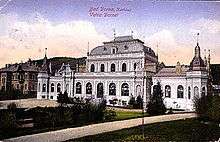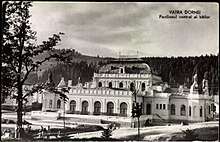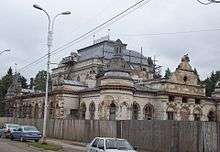Vatra Dornei Casino
The Therapeutic Baths’ Casino of Vatra Dornei, also known as the Vatra Dornei Casino (Cazinoul Bailor OR Cazinoul din Vatra Dornei), is an abandoned historic monument located in Suceava County, Romania in the town of Vatra Dornei. It was built in 1898 by Austrian architect Peter Paul Brang while the territory was part of the Austro-Hungarian Empire.[1] It is located on the Dorna River.
| Vatra Dornei Casino | |
|---|---|
| Native name Romanian: Cazinoul Bailor | |
| Cazinoul din Vatra Dornei | |
 | |
| Location | Suceava County, Romania |
| Nearest city | Vatra Dornei |
| Coordinates | 47°20′46″N 25°21′34″E |
| Built | 1898 |
| Built for | General Use |
| Original use | Casino |
| Current use | Abandoned |
| Architect | Peter Paul Bang |
| Architectural style(s) | Eclectic; Revival Renaissance |
| Governing body | Ministry of Culture and National Patrimony (Romania) |
| Type | Architectural Monument of National Interest |
| Designated | 2004 |
| Part of | National Register of Historic Monuments (Romanian: Lista Monumentelor Istorice (LMI)) |
| Reference no. | SV-II-m-A-05670 |
 Vatra Dornei Casino | |
It was initially constructed as an entertainment venue for tourists of Austria-Hungary whom would flock to the nearby therapeutic baths. The baths offered mineral water treatments, carbonic acid baths, and mud wraps for visitors while the nearby casino offered poker, craps, and roulette.[2] The casino initially was designed to attract Viennese tourists looking for treatment. Local authorities hired traveling bands from Vienna and the structure itself was built as a sister casino to the current Grand Casino in Baden bei Wien, Austria, mimicking its design. In its heyday, the Casino attracted tourists from all over Austria-Hungary, mainly from Vienna, Berlin, and Budapest, but also Italian and Jewish travelers.[3][4]
The Casino opened its doors in 1898 and served personalities such as Emperor Franz Joseph and Archduke Franz Ferdinand, but also other regional notables, such as Lucian Blaga, Nicolae Iorga, Corneliu Zelea Codreanu, Nichifor Crainic, Emil Bodnăraş, Eugen Jebeleanu, Zaharia Stancu, and Gheorghe Gheorghiu-Dej.[5] The casino also hosted Soviet generals on their way to Berlin in World War II.
Today, the casino is abandoned.
History
Financing, Inauguration, and Construction
Joseph II, Holy Roman Emperor, instituted a series of policies between 1765–1790 now known as Josephinism, which acted to decentralize church institutions.[6] In essence, this policy prohibited local churches from speaking directly to the Curia in Rome or other centralized bodies as with Orthodox churches. Practicing Jews of Bukovina were also targeted by the occupying Monarchs.[7] The consequence of the policy was the bankruptcy and shuttering of over 800 monasteries and local churches and the forfeiture of their funds and vast properties to the government. It also resulted in the centralization of active church property. The newly acquired funds and properties were turned into public, secular church-fund bureaucracies (in German: Religionsfonds[8]) resulting in the creation of 1,700 new welfare institutions and parishes.[8][9]
After the annexation of Bukovina by the Habsburg monarch from the Principality of Moldavia in 1775 (which later became part of the Austrian Empire in 1804 and Austria-Hungary in 1867), the monarch appointed Baron Erzenberg as governor over the new military administration of the region. At the time, churches and monasteries owned two-thirds of all wealth and land in Bukovina.[10][11]
Under the June 19, 1783, imperial decree of Joseph II, the Baron was ordered to begin the centralization of church-owned lands and wealth.[12][13] The local Eastern Orthodox Eparchy of Bukovina, seated in Chernivtsi, was placed under spiritual jurisdiction of Metropolitanate of Karlovci.[14]
Translated from Romanian, the decree ordered, in part:
fără amânare să se reducă numărul mănăstirilor, iar pământurile şi fondurile să treacă sub povăţuirea stăpânirii împărăteşti şi crăieştii Mării. Averea preoţilor care nu trăiesc în Bucovina să se confişte, iar din întreg fondul care se va forma pe această cale să se întreţină clerul ortodox şi să se creeze cel puţin o şcoală, fie la Cernăuţi, fie la Suceava, iar restul să se întrebuinţeze pentru scopuri folositoare.[15][16]
Without delay, by order there will be a reduction of the number of monasteries, and the lands and funds will pass under the wisdom and responsibility of the dominion of the Kingdom and in the care of the Monarch. The wealth of priests who do not live in Bucovina are hereby confiscated, and from the entire confiscated church-fund will support the Orthodox clergy but will also create at least one school, either in Chernivtsi or in Suceava, and the rest to remaining church-fund shall be allocated for useful purposes.
The order additionally required the confiscation of wealth from priests whom lived outside of Bukovina to establish a school in the territory, either in Chernivtsi or in Suceava. In 1786, the Church-Fund of Bukovina was created from the possessions of the Orthodox churches in the territory, and like similar funds, it was to be a secular institution whose wealth was to be used for public benefit and public reinvestment.[16]
The communal land upon which the Casino resides was old church land managed by the local church-fund bureaucracy known as Fondul Bisericesc al Bucovinei (Church-Fund of Bukovina).[16] A portion of confiscated church money, which was secularized, was used to fund the casino.[17]
In 1805 after a scientific analysis and study of the natural and mineral springs in Vatra Dornei by chemist Hacquette de Nurnberg, Dr. Ignatius Plusch advocated authorities for the construction of public therapeutic baths in Poiana Negrii.[18] In 1810, he proceeded to lobby in Vienna for the Vatra Dornei baths. The land on which the communal therapeutic baths were located was purchased by the secularized church-fund in 1870. For those with extreme illnesses, a 20-cabin property was erected where, later, Hotel Nr. 1 would be built.
Inauguration and Construction
The casino's existence can be credited to then-mayor Vasile Diac of Vatra Dorna, who initiated and lobbied for the project but later committed suicide by shooting himself over allegations of fraud and theft of city funds.[19] The mayor pitched the project to Emperor Franz Joseph, whom approved the works. The casino was to be constructed near the therapeutic baths and built on communal forested land, confiscated from the church. The land required to be deforested. A portion of the money needed to build the casino was appropriated from the Church-fund of Bukovina, raised through fundraisers and community donations, to which Emperor Franz Joseph had also contributed. The remaining portion was borrowed from a bank in Vienna.
Construction of the building began in 1896 by Austrian architect Peter Paul Brang. The building was designed in an eclectic style, with hints of German Renaissance Revival. In 1898, a partial inauguration took place. The official inauguration occurred July 10, 1899 and hosted Emperor Franz Joseph and Arch Duke Ferdinand.
The building opened to serve Viennese tourists, with local authorities using gambling taxes to repay the debt and finance local services. The casino comprised a theatre hall, a library, a restaurant, a confectionery, and public utility spaces. Three large Murano Crystal chandeliers adorned the ceilings, initially being lit by candlelight followed by electrification and lightbulbs. To accommodate the tourists, a train line opened nearby, and wealthy tourists were transported from the train station by coach to the therapeutic baths and to the casino complex.
Local urban myth has it that a secret tunnel was built under the casino to offer an escape route for winners of large sums as a way to avoid robbery and harassment.
The Casino in the 20th Century

After the Great Unification of Romania, where Romania gained possession, amongst other things, of Bukovina, the Austrians were required to pay War Reparations to Romania for World War I. As part of their payment, the Austrians handed over the Church-Fund of Bukovina.[20] The land was reconstituted back to the Metropolis of Moldavia and Bukovina, with administrative rights changing hands several times between the Minister of Agriculture and the church leadership.
The Casino was then known as Central Pavilion of the Therapeutic Baths (Pavilionul Central al Băilor). Since 1936, a number of functional changes of the building have occurred. Due to the functional changes, the artistic imagery in the casino's performance hall was altered. In the back of the casino, a terrace overlooking the Spa Park was completed in 1937.[21]
During World War II, the building was utilized by Nazi armies for military purposes. On the morning of September 29, 1944, during the withdrawal of German military units from Vatra Dornei, the casino building, and especially the inner spaces, suffered significant damage. In the spring of 1945, a number of repairs were initiated.[21][22]
After the communists came to power in Romania, the casino property was nationalized and turned into a workers club, which combined propaganda, educational, and community center functions (similar to the Melnikov Clubs such as Rusakov Workers Club). Party meetings would be held in the club, local syndicate meetings, local communist committee functions, but also host the National Chess Championship of Communist Romania.
In the early part of 1986, extensive restoration and renovation work of the surrounding perimeter had started; the street from the Dorna River was transformed into a boulevard. According to the statements of Ioan Corneţchi, former mayor of Vatra Dornei between 1986–1989, Dictator Nicolae Ceaușescu approved the remake of the Casino in 1987. The work had to be completed within three years, and host the Ceaușescu's 1990 New Year Celebration, which never occurred due to the Romanian Revolution.[1][3]
After the country fell into economic paralysis due to the 1989 Revolution, the interior of the casino was pillaged. According to local records, after the first three months of the fall of communism, all chandeliers were stolen, copper tubs and plumbing was taken, the interior was stripped of metal, the Carrara marblework was taken, all decorative crystal glasses, windows, and kitchenware was taken. Work ceased on the Casino.
 "August 23" Spring at the Therapeutic Bath Complex of Vatra Dornei
"August 23" Spring at the Therapeutic Bath Complex of Vatra Dornei Central Pavilion of the Therapeutic Baths (Pavilionul Central al Băilor)
Central Pavilion of the Therapeutic Baths (Pavilionul Central al Băilor) Vatra Dornei Baths- Train Line
Vatra Dornei Baths- Train Line Vatra Dornei Casino
Vatra Dornei Casino.png) Interbellum Casino of Vatra Dornei
Interbellum Casino of Vatra Dornei
Post-Communist Era

After 1990, the casino was in the care of the Dorna Turism SA society. Then, by Government decision, in 1995, the building was transferred to the Local Council of Vatra Dornei. The council managed to approve a project in 1998, with funds from the Ministry of Culture and Cults (Ministerul Culturii şi Cultelor ) for the rehabilitation of the building, and local authorities spent huge amounts for the foundation and substructure. In 1998, at the initiative of Mayor John Moraru, the city Council of Vatra Dornei decided to establish the "Vatra Dornei Casino" Foundation in order to find the necessary financial resources for restoration and consolidation of the Casino.
However, in January 2003, the Archdiocese of Suceava and Rădăuţilor, as the legal administrator and successor of the church-fund of Bucovina (Romanian Orthodox Church fund in Bucovina) created on June 19, 1783, claimed the casino building.
On October 14, 2004, Government Decision No. 437 restituted the Casino, the Infectious Diseases building, and a building at the base of Runc Hill, to the Archdiocese, following an investigation by the Special Commission for Restitution of Religious Property. Due to Property Restitution Laws in Romania, the Romanian Orthodox Church is one of the largest owners and administrators of historical heritage sites.[23][24][25]
At the time the building was returned, local priest Mihai Valică of the local "Holy Trinity" Church in Vatra Dornei threatened state authorities with lawsuits for allowing the destruction of buildings.[1][3]
A contract was signed December 2017 to fund the rehabilitation of the Casino with European Funds and turn it into a Museum. It was signed in the presence of Director of Regional Development for North East Romania, Vasile Abu, and the Archbishop of Suceava and Rădăuţilor.[26]
References
- Plaiaşu, Ciprian (14 February 2013). "Cazinoul din Vatra Dornei, simbolul oraşului, îngropat de biserică". Adevarul News. Retrieved 11 April 2018.
- Apavaloaie, Catalin. "Istoric". scvd.ro. Save the Casino of Vatra Dornei. Retrieved 12 April 2018.
- Zuzeac, Danut (4 December 2017). "Cel mai vechi cazino din România va fi reabilitat, după 28 de ani de ruină. Clădirea se află acum în proprietatea Bisericii Ortodoxe Române". Adevarul. Retrieved 11 April 2018.
- Anda, Raluca. "Salvaţi Cazinoul din Vatra Dornei". Aboutro.com. Retrieved 12 April 2018.
- Borhan, Stelian. "O floare şi o lumânare la Cazinoul din Vatra Dornei". 9 July 2011. Monitorul De Suceava. Retrieved 11 April 2018.
- Ingrao, Charles W. (2000). The Habsburg Monarchy, 1618–1815. New York: Cambridge University Press.
- Gelber, N. M. (1958). History of the Jews in the Bukovina [Geschichte der Juden in der Bukowina] (1774-1914). Volume I. Tel Aviv. pp. 11–66. Retrieved 13 April 2018.
- Isidor Onciul, „Der griechischorientalische Religionsfonds”, în Die österreichisch-ungarische Monarchie in Wort und Bild, Bukowina, Wien, 1899, p. 154-174.
- Okey, Robin (2002). The Habsburg Monarchy c. 1765–1918. New York: Palgrave Macmillan. p. 26.
- Lazăr Gherman, Problema istorică a Bisericii din Bucovina, Tipografia profesională „Dimitrie C. Ionescu”, Bucharest, 1914;
- Suceava. Anuarul Complexului Muzeal Bucovina [Suceava. The Yearbook of the Bucovina Museum Complex] (PDF) (in Romanian). XXXVII. Suceava, Romania: University of Suceava, Bucovina Museum. 2010. ISSN 1583-5936. Retrieved 13 April 2018.
- "Cronologie concordantă și antologie de texte". Putna.ro. Putna Monastery Archives. Retrieved 13 April 2018.
- "Putna in the Light of Chronicles". Putna.ro. Putna Monastery Archives. Retrieved 13 April 2018.
- Preot Sorin-Toader Clipa, Fondul bisericesc al Bucovinei și lichidarea lui (1948–1949), Editura Universității „Ștefan cel Mare”, Suceava, 2006
- Livezeanu, Irina (1995). Cultural Politics in Greater Romania. Cornell University. pp. 49–55.
- Ciobanu, Petre (1993). "Fondul Bisericesc Ortodox Român din Bucovina (1783–1948). Prezentare generală" [The Roman Orthodox Church Foundation in Bucovina (1783-1948). General Presentation] (PDF). Bucovina Forestieră (in Romanian). 1 (1–2): 5–17. Retrieved 12 April 2018.
- Constantinescu, Gheorghe (1939). Averile bisericești din Bucovina. Cernăuți: Mitropoliei Bucovinei. p. 9.
- "VATRA DORNEI". Romanian Government. Asociatia Nationala a Statiunilor Balneare si Balneoclimatice din Romania. 10 September 2017. Retrieved 11 April 2018.
- Abutnaritei, Ioan (7 July 2014). "Cazinoul din Vatra Dornei A Fost Mandria Imperiului Austriac". Dorna Monitor (Cultural). Retrieved 11 April 2018.
- Plaiasu, Ciprian (12 November 2013). "Cum Ingroapa Biserica Simbolul Orasului Vatra Dornei". Historia. Retrieved 11 April 2018.
- Vladica, Mircea (2007). Vatra Dornei: Plai mioritic de istorie si legenda, leagan de credinta si cultura. Cluj-Napoca: Napoca Star.
- Biblioteca Suceava. "Cazinoul din Vatra Dornei". Istorie Locala. Retrieved 13 April 2018.
- Dima, Alin (12 October 2017). "Cazinoul din Vatra Dornei va fi restaurat printr-un proiect european de 4,9 milioane euro" (Nr. 7712). Crai Nou News. Retrieved 13 April 2018.
- Pardau, Cipirian (7 November 2014). "Cazinoul Din Vatra Dornei: Un pas de restaurare dupe 49 de ani". Dorna Monitor Newspaper. Retrieved 13 April 2018.
- "BOR conditioneaza restaurarea unei cladiri simbol de retrocedarea unui parc. Cum a ajuns primul cazinou din tara o ruina" (Social). ProTV. Pro TV News Agency. 23 August 2015.
- Ziarul Lumina (1 December 2017). "Cazinoul din Vatra Dornei, reabilitat cu bani europeni". Lumina Newspaper. Retrieved 13 April 2018.